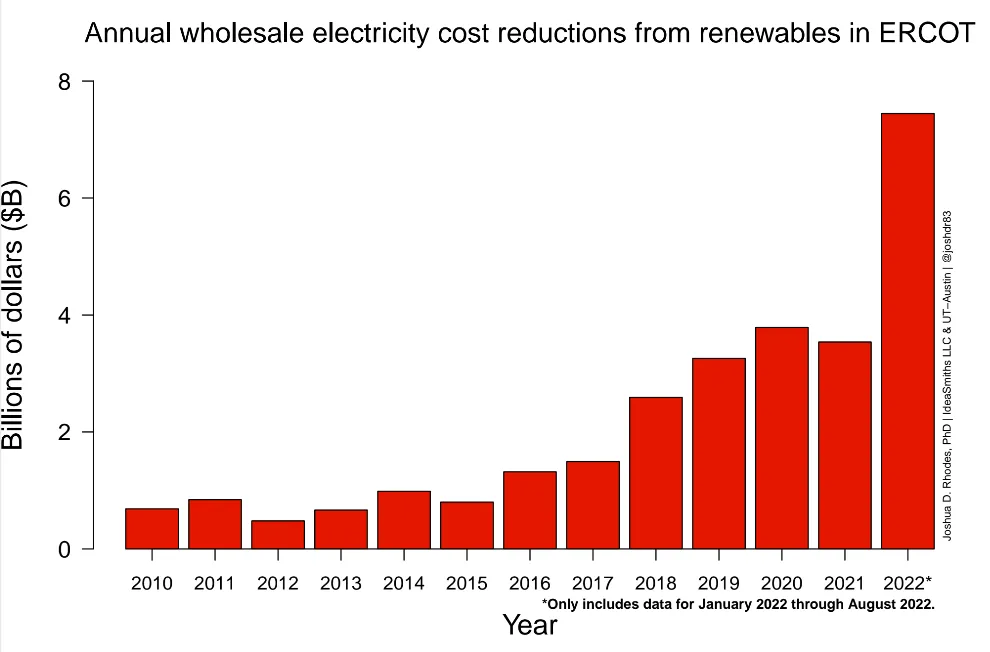Dive Brief:
- Solar and wind energy reduced wholesale energy costs in Texas by $7.4 billion in the first eight months of this year, creating average monthly savings of $925 million, according to a study IdeaSmiths released last week. In total, solar and wind resources have saved Texas residents nearly $28 billion over the past 12 years, according to the study.
- With natural gas and coal prices at 10-year highs, Texas residences and businesses are on track to save an estimated $11 billion this year because of the Electric Reliability Council of Texas’ renewable energy fleet, the report states.
- Using more renewable power and less fossil-fueled generation also has reduced air pollution, including carbon dioxide, nitrogen oxides and sulfur oxide emissions, and curbed the use of limited water supplies, it states.
Dive Insight:
Texas leads the U.S. in wind installations, with 30.46 GW, and it’s second in solar energy, with 8.6 GW as of August. These resources have provided significant financial and health benefits, according to research by Joshua Rhodes, chief technology officer of IdeaSmiths, an energy systems analysis firm based in Austin, Texas.
“Texas needs to double down on these benefits, growing consumers’ savings by increasing solar and wind resources,” Sandie Haverlah, president of the Texas Consumer Association, said in an Oct. 18 statement.
The report compares the actual performance of ERCOT’s market with how it would have performed minus the solar and wind resources.

Renewables “have reduced wholesale electricity market prices on average between $1.17/MWh (in 2012) and $20.60/MWh (in 2022) by offsetting more expensive power plants,” according to the report.
The gain to consumer pocketbooks has been larger this year because of increased wind and solar generation as well as natural gas and coal prices that were much higher than they were in earlier years, it states.
This year, gas prices averaged $6.24 per million British thermal units, compared with $3.64 per MMBtu last year. Coal prices rose in 2022 to $3.72/MMBtu compared with last year’s price of $3.26 MMBtu. The report notes that thermal power plant marginal costs vary depending on their specific characteristics.
In addition to experiencing a jump in natural gas and coal prices, the Lone Star State had a very hot summer, driving up demand and increasing the value of grid-connected renewables.
The renewable-generated electricity reduced pollution, particularly in dense, overburdened communities, by displacing fossil-fueled generation, the report states. The intermittent resources were found to have avoided 416,000 tons of SO2, 318,000 tons of NOx, and 558 million tons of CO2 emissions since 2010.
For seriously impacted communities, Rhodes valued the avoided SOx emissions up to $107,000 per ton and NOx emissions at $12,000 per ton because of fewer hospitalizations of patients suffering respiratory impacts. The report gave median emission values for SOx at $16,600/ton, NOx at $4,750/ton and CO2 at $20/ton.
The drop in emissions has saved Texans between $10.2 billion and $76.4 billion in healthcare and other environmentally related costs, the report states.
Unlike fossil-fuel generation, the intermittent renewable resources do not use fresh water for power plant cooling, Rhodes said. The solar and wind resources avoided the consumption of “244 billion gallons of power water from 2010 to August 2022, [which would have been] adding water stress to regions that are often in drought,” the report states. Rhodes estimated those savings as being between $0.7 billion and $1.7 billion













